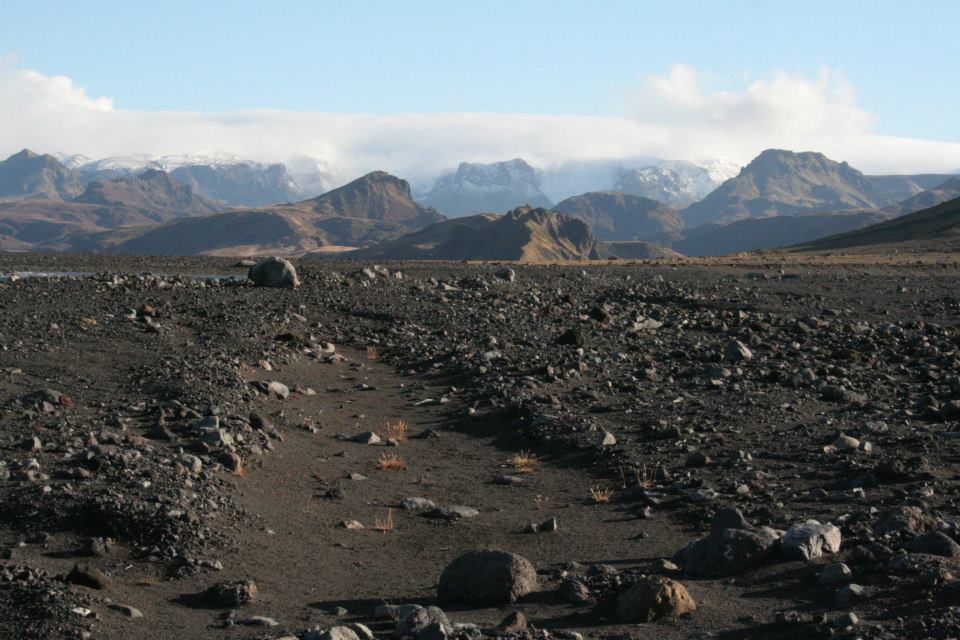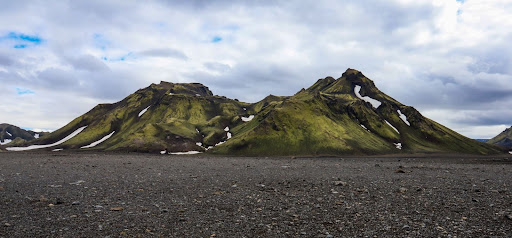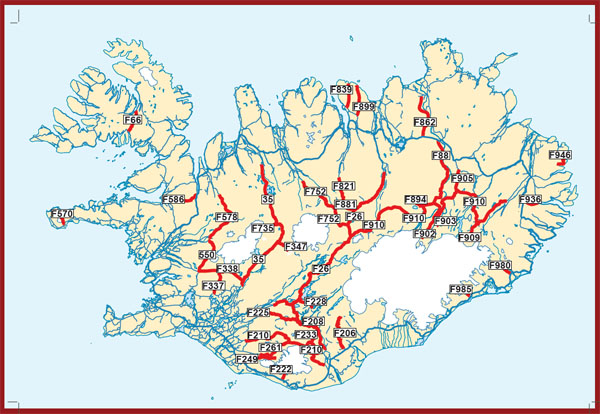Headed for the rugged and beautiful F roads in the highlands of Iceland? Our driving tips will help you stay safe and enjoy your Iceland Highlands tour.
The mountain roads in the Icelandic highlands are called F-roads. The highlands of Iceland are large, sparse zones of volcanic desert which cover a large amount of the interior of Iceland. The rugged beauty and the powerful peace and quiet found there is brilliant to recharge your batteries after months of hard work and stress.
Iceland’s F-roads are primarily narrow gravel roads that cross directly through rivers and are only navigable by 4x4. The challenging landscapes you’ll encounter when driving these roads mean you’ll be thankful for your 4-wheel drive. Be aware that Kjalvegur will also require a 4x4 beyond Gullfoss, despite not being marked as an F-Road.
We’ve put together a guide to help you stay safe when navigating the F-Roads in Iceland, and to make sure you enjoy the scenery without getting caught in a powerful river or finding yourself stuck in the middle of nowhere as snow begins to fall!
The information in the F-Roads guide below includes:
- Your Iceland F-Roads checklist
- Driving Tips
- Opening Times
- List of F-Roads in Iceland
- F-Roads Map
- Hiring a Vehicle to Drive
- What Can You See in the Highlands of Iceland?

Your Iceland F-Roads Checklist
F-Roads are not to be attempted without some preparation. Woefully underprepared visitors will pay the price, and you could even be stranded if your vehicle becomes stuck and requires rescue. Before you travel, there are a few things you should take care of first:- Ensure you have a suitable 4x4 vehicle. Other types of vehicles are not properly equipped to tackle the difficult terrain more commonly seen on F-Roads than on other main Icelandic highways. Browse our range of 4x4 vehicles for your Iceland highlands tour.
- Let someone know your travel plans in case you encounter any difficulties in the Highlands. This can be a friend, a local ranger, or the good people over at www.safetravel.is.
- Ensure you have a detailed map of the route you will be travelling. Standard maps available from our offices, or from gas stations and tourist information centres might not be as helpful - find a map of Iceland’s F-Roads further in this article.
- Double check the conditions before you start your journey. You can call 1777 or check www.road.is to ensure the F-Roads are safe. Checking with local people and rangers as you encounter them is also a good idea.
Driving Tips for F-Roads in Iceland
All of the roads in Iceland require extra caution. However, whilst travelling on the F-Roads in Iceland, there are some additional tips that you should follow to help keep you safe:
- It is strongly advised that people travel together in 2 or more cars in case you encounter trouble and need help.
- Make sure that the roads you plan to travel on are open for traffic. Road opening times are listed in this blog.
- Drive slowly and be aware that the road ahead is likely to be gravelly, wet, and quite likely to have potholes.
- Avoid crossing rivers, or if you do, cross with extreme caution. Learn more from the Safe Travel website about Highland Driving.
- Driving off the designated roads in the highlands is strictly forbidden. It's worth noting that driving off-road anywhere in Iceland is always forbidden!
- Be prepared for all types of weather. The weather in the highlands can change in a blink of an eye.
- Be aware that the telephone signal in the highlands is not very stable and you can go for a long while without a mobile connection.
- The emergency number in Iceland is 112. You are able to call it in the highlands, even without a mobile connection.
- There is only one petrol station in the highlands, at Hveravellir, so make sure you fill up!
The Road Traffic Directorate has made a video about how to drive in Iceland. It is mostly a general video about driving in Iceland, however, it does contain some information about how to drive on F-Roads.

Opening Times
The F-Roads in Iceland are only open during the summer. Some of them open as late as early July and close again in mid to late September. The opening of each road depends mostly on the amount of snow covering them. Roads can be very wet after the spring and are not open to traffic until they dry up. When roads pass through conservation areas, they are not opened until the whole area is ready to take on the pressures of visitors. This means that the estimated opening dates below are subject to change:
List of F-Roads in Iceland
| MOUNTAIN ROADS 2011 - 2015 | Opening date earliest | Opening date latest | Opening date median |
|---|---|---|---|
| Lakagígar, F206 | 12 June | 25 June | 18 June |
| Fjallabaksleið nyrðri, F208 | |||
| 1. Sigalda - Landmannalaugar | 24 May | 19 June | 9 June |
| 2. Laugar - Eldgjá | 14 June | 8 July | 29 June |
| 3. Eldgjá - Skaftártunga | 5 June | 16 June | 12 June |
| Fjallabaksleið syðri F210 | |||
| 1. Keldur - Hvanngil | 21 June | 10 July | 4 July |
| 2. Hvanngil - Skaftártunga | 28 June | 13 July | 5 July |
| Landmannaleið (Dómad.) F225 | 28 June | 18 July | 26 June |
| Emstruleið, F261 | 21 June | 8 July | 2 July |
| Kjalvegur, 35 | |||
| 1. Gullfoss - Hveravellir | 8 June | 1 July | 17 June |
| 2. Hveravellir - Blönduvirkjun | 2 June | 25 June | 13 June |
| Sprengisandur, F26 | |||
| 1. Hrauneyjar - Nýidalur | 20 June | 9 July | 1 July |
| 2. Nýidalur - Bárðardalur | 20 June | 9 July | 1 July |
| Skagafjarðarleið, F752 | 26 June | 9 July | 5 July |
| Eyjafjarðarleið, F821 | 28 June | 24 July | 10 July |
| Öskjuleið, F88 | |||
| 1. To Herðubreiðarlindir | 14 June | 1 July | 21 June |
| 2. Herðubreiðarlindir - Dreki | 14 June | 1 July | 20 June |
| Öskjuvatnsvegur, F894 | 14 June | 6 July | 21 June |
| Hólsfjallavegur, F864 | 2 June | 29 June | 13 June |
| Kverkfjallaleið, F902 | 14 June | 30 June | 20 June |
| Arnardalsleið F905 | 11 June | 30 June | 19 June |
| Austurleið F910 | 11 June | 17 July | 28 June |
| Uxahryggjavegur, 52 | 16 April | 16 May | 1 May |
| Kaldadalsvegur, 550 | 4 May | 19 June | 25 May |
Opening of mountain roads brochure (updated August 2022).
F-Roads Map

Hiring a vehicle to drive on the F-roads in Iceland
You will need a suitable 4x4 car to drive in the Iceland highlands. At SADcars, we offer several groups of vehicles that are suitable for F-road driving;
- Group M (manual) and Group N (automatic) Toyota RAV4 4x4 or comparable)
- Group J Suzuki Jimny 4x4 (not suitable to drive on all highland roads under all circumstances, it depends on the amount of water flow in the rivers if they can be crossed)
- Group R (Toyota LandCruiser 4x4 or comparable).
The notable exception to the 4x4 requirement is Kjalvegur road 35 (usually called Kjölur among Icelanders). Kjölur does not become an F-Road until right after Gulfoss, which means you are able to drive to and from Gullfoss in a standard car.
It’s important to note that regardless of your vehicle, driving off-road in Iceland is strictly forbidden. It can cause lasting damage on the landscape if you drive on roads without assigned numbers. Punishment can include huge fines or even imprisonment for up to 2 years.
Sources and useful information:
What Can you see in the Highlands of Iceland?
The rolling landscape consists of many of the following at all times: black sands, green mountain tops, rock formations of different varieties, blue or brown rivers, colourful hot springs, small waterfalls, big waterfalls and black volcanoes to name just a few. Sometimes you go whole days without seeing a single person and other times it is like being in busy downtown Reykjavik on a lovely Saturday. Iceland’s highlands can offer a huge array of experiences.
The Highlands are home to many of Iceland’s glaciers such as Vatnajokull, which is one of the biggest glaciers in Europe. Most of Iceland’s active volcanoes are also situated in the highlands. Sounds amazing, right?
Always keep in mind that you are driving in a wilderness where the weather can change very quickly. You are located high above sea level so the weather can be very different from the weather in the "lowlands". For more driving tips and guidance, read our advice on safe travel in Iceland.
Have a happy and safe journey!
